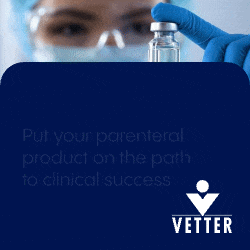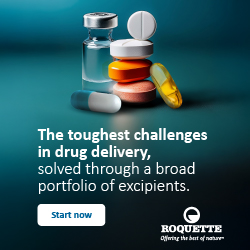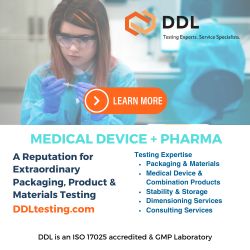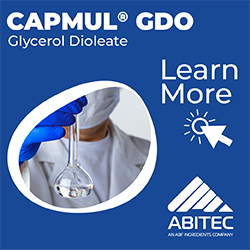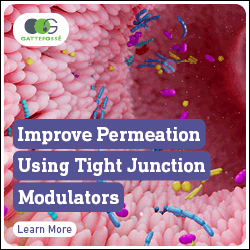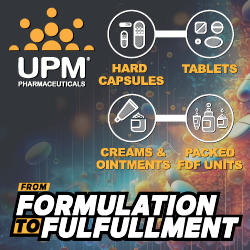WHITEPAPER - Versatility of Geleol™ Mono- and Diglycerides NF
By: Jasmine Musakhanian, Senior Scientific Director, Gattefossé
INTRODUCTION
Mono and diglycerides, also known as partial glycerides, are versatile lipid excipients that play a pivotal role in the realization of drug products and nutraceuticals. Some well-known excipients in this category are Compritol® 888 ATO (glyceryl dibehenate, NF), Labrafac™ MC60 (glyceryl mono caprylocaprate, NF) and Geleol™ (mono and diglycerides, NF). Geleol™ simply referred to as Geleol hereafter is the focus of this article[1]. It conforms also with the European and Chinese pharmacopoeia under designations respectively of glycerol monostearate 40-55 (Type I) and glyceryl mono- and distearate. These designations relate to the composition of the product which is obtained by direct esterification of two fatty acids namely palmitate (C16:0) and stearate (C18:0) with glycerol. Geleol is also listed as food additive in the USA, Japan, and Europe according to the FCC, JSFA, and E471 monographs.
Generally recognized as safe (GRAS), Geleol is suitable for oral and topical products in pediatric formulations. GRAS substances are not subject to admissible daily intake limits. Nevertheless, the FDA Inactive Ingredients Database (IID) is a point of reference for precedence of use[2]. With a read-across approach, on must search for current as well as older denominations in the IID which includes glyceryl monostearate (GMS), glyceryl dipalmitostearate, and mono and diglycerides. Table 1 provides a short list of these denominations and approved limits by various routes of administration. Under “glyceryl monostearate” for example, one finds a maximum potency of 264.3 mg per extended-release tablet, 9% in a topical lotion, and 17% in a vaginal cream.
Table 1. Various denominations in the IID related to Mono and diglycerides, NF

The list of globally approved drug products with Geleol, however, is even more extensive. Table 2 provides examples of drug products in the USA, Europe, and Asia including oral and topical references administered among others also to pediatric populations. The incorporation of Geleol in a wide array of products listed (Tables 1 and 2) is indicative of its innocuity, safety, and versatility. Depending on the type of delivery system, Geleol may function as cosurfactant, consistency agent, and/or drug release modifier. Additionally, it can serve as glidant and plasticizer in polymer coatings – as described below.
Table 2. Selected examples of drug products in Asia, Europe and USA

Explaining the versatility of the described functions are the physic-chemical properties of Geleol. Stearate (C18:0) and palmitate (C16:0) constitute >98% of the fatty acids within the Geleol glycerides. The mono- and di-esters combined account for > 90% of the glyceride composition (Figure 1), imparting hydrophilicity to the product with an HLB (hydrophilic/lipophilic balance) of 3. The carefully controlled repartition provides the right polarity, hydrophobicity, plasticity (melting range), and oxidative stability of Geleol in various dosage forms and a wide array of processing technologies (Table 3). The other defining aspect of the product is its’ solid-state behavior. The melting point data from >100 manufactured batches is 58.24°C ± 0.3 (by drop point method) and 58.87°C ± 0.4 (by capillary tube method)[1]. The melt and crystallization characteristics of the product are represented by endotherms and exotherms obtained by differential scanning calorimetry (Figure 2).
Figure 1. The repartition of mono, di, and tri-esters of palmitate and stearate in Geleol

Table 3. Various applications of Geleol by function and processing technology

Figure 2. Differential Scanning Calorimetry analysis – Heating, cooling, and reheating endotherms of Geleol™ by DSC
ORAL DELIVERY
Among the mainstream applications of Geleol™ in oral delivery are taste masking and drug release modification, primarily with solvent-free formulation techniques, such as direct compression or melt technologies like melt extrusion for the preparation of lipid-based solid dosage forms[3, 4]. In topical formulations such as emulsions, ointments, and oleo gels Geleol imparts structural integrity to the oil (lipid) phase. Below are various applications and functions by processing technology.
Dispersion in Molten Lipid
The simplest technique for developing lipid-based matrices involves dispersing the API in the molten lipid, followed by stirring the mixture to obtain a homogenous solid matrix upon cooling. The mixture may be molded into tablets or capsules. Alternatively, the solidified mass may be grinded into powder for direct compression. Additionally, water-soluble fillers and surfactive lipids may be incorporated into the matrix to modify the rate of drug release[3-5]. To develop verapamil HCl sustained release tablets, glyceryl monostearate was used the lipid matrix at drug-lipid ratios of 1:1, 1:2, and 1:3[6]. The mixtures were prepared by heating the lipid to 75°C before gradually adding verapamil to the molten lipid while stirring continuously and then allowing it to cool and solidify at room temperature. The solid mixture was grinded and sieved before incorporation into the tablets, representing 10%, 20%, or 30% lipid in the matrix. Based on the dissolution profiles compared to that of a market reference, the 20% lipid in the matrix was found to be optimal for releasing 80% of the drug in 8 hours – equivalent to the marketed.
High Shear (Melt) Granulation
Lipid excipients may be used as meltable binder in high shear granulation to achieve taste masked or sustained release granules or powders obtained. The process does not require solvents. The heat generated during the mixing process is sufficient to soften (partially melt) the lipid to facilitate is’ function as binder or coating agent for the dispersed solids. Incorporation of a solid lipid as binder helps also reduce the amount of polymer needed to achieve a desired drug release profile. The process is easier to control when the mixer is equipped with a heating.
The dependence of drug release on the degree of hydrophobicity, melting point, and digestibility of glycerides have been reported by several other works [7-9]. Thies [7] studied the effect of Geleol, PEG, and hydrogenated castor oil on the preparation of sodium valproate granules. Among the variables tested were drug solubility in the binder, the percentage and viscosity of the binder, and the speed of mixing during palletization. The fastest pelletization time and the highest sodium valproate solubility were associated with Geleol. The study concluded that granule size and growth rate during pelletization is mainly influenced by the solubility of sodium valproate in the molten binder.
Another study[9] demonstrated the feasibility of incorporating Geleol to mask the bitter taste of metoclopramide HCl. Drug :Geleol mixtures at 1:0, 1:1; 1:2; 1:3 , and 1:4 ratios, representing 0, 50, 67, 75, and 80% Geleol were prepared. As illustrated in Figure 3, complete taste masking was achieved by granulating drug with Geleol at 1:4 ratio (80% Geleol). This was attributed in part to the hydrophobicity of the Geleol coating and also the decreased surface area of the drug within the larger particle sizes following granulation .
Figure 3. Taste masking scores (n=6) for metoclopramide HCl: Geleol complexes at various ration. (Ahire 2012)

Melt Extrusion
Melt extrusion (HME) is a solvent-free continuous process that facilitates drug dispersion, amorphization and/or solubilization into the excipient/formulation core. The technique is amenable to extended release, enhanced solubility/bioavailability, taste masking, and drug protection. A certain drawback of the polymers used in HME is the relatively high glass transition (Tg) temperatures of 100 – 200 °C, which means processing at an additional 20°C, above the Tg. Lipids can be extruded at significantly lower temperatures because of their relatively low range of melting point ( 30 to 75°C). It is proposed that by positioning themselves within the entangled polymer chains, lipids increase polymer mobility and reduce the glass transition temperature of the extrusion process.
Polymer-based sustained release matrices are known for a major drawback, dose dumping. Lipid-polymer combinations on the other hand can help expand the window of opportunities for sustained and/or controlled drug delivery of the extrudates [10, 11]. To develop polymer/lipid combination matrices, Nyavanandi [11], used twin screw melt granulation, combining quetiapine fumarate as model drug, Geleol as lipid matrix, and different hydrophilic binders, before compression into tablets. Figure 4a details the tablet formulation compositions. The release of quetiapine fumarate from these formulations in Figure 4b indicated that sustained release could be achieved with 15% Geleol with either 5% Klucel™ EF or 5% Kollidon VA64 as binder. However, the release rate was much higher, 60%, within 24 hrs. when Kollidon 12PF was used as binder. Lastly, 100% release within 16 hrs. was achieved with Kollidon 12PF when Geleol percentage was raised to 20% at the granulation step. Overall, the results suggest the possibility of adjusting the drug release profile between 16 to 24 hours by changing the lipophilic and hydrophilic constituents. Moreover, these formulations were stable under accelerated conditions (6 months) with no dose dumping in ethanol. Meanwhile the same formulations obtained by direct compression (no granulation step) resulted in loss of matrix and dose dumping. It was concluded twin screw melt granulation provides uniform distribution of the softened binder resulting in reproducible and stable matrices.
Figure 4. a) four different formulations of Quetiapine fumarate; b) Release of Quetiapine fumarate from the aforesaid four formulations (Nyavandi 2021)

Glidant, Lubricant, Anti-Adherent
Glidant and plasticizer are other notable functions of Geleol. Polymer coatings are often used for masking drug taste and/or enteric coating in delayed release delivery. Glidants are needed to improve the coating process especially when pH sensitive coatings like aqueous poly(meth)acrylate suspensions are sprayed onto granules or tablets[12]. Geleol may be added at 2%-15% of the polymer dry weight along with a surfactant like polysorbate 80 for anti-tacking effects, allowing the incorporation of higher amount of polymer, faster drying time, and increased flexibility of the coating films relative to coating films formulated with talc as glidant. In addition to reduced sedimentation of the pigments during coating, Geleol can improve tablet gloss, and provide two-years of stability under accelerated conditions .
TOPICAL FORMULATIONS
As a non-ionic lipid with mild surfactive properties, Geleol has a stabilizing effect on conventional formulations where it functions as a co-emulsifier and/or consistency agent in topical and dermal formulations such as emulsions, sprayable lotions, ointments, and balms. Emulgels are another category, preferred for non-greasy, rapid absorption characterized by easy spreading and fresh cooling sensation. To this effect, Calpena et al [13] developed emulgels of diclofenac sodium (1%) using several excipients, including Geleol as stabilizer. Other examples of topical formulation systems are provided below.
Nano-Lipid Systems
Obtained by hot melt emulsification using high pressure homogenization, solid lipid nanoparticles (SLN) and nanostructured lipid carriers (NLC) are promising colloidal drug delivery vehicles for oral, topical, and other administration routes. Acting as drug reservoirs, these submicron particles are typically prepared from physiologically compatible lipid excipients. As such, the use of Geleol in NLC and SLN has been reported for both lipophilic and hydrophilic drugs[13-17]. SLNs have a solid core and are typically produced by high-pressure homogenization of the drug in a solid lipid matrix with an aqueous solution of surfactants. NLC on the other hand, carry the classic solid components of SLN except for allowing the inclusion of a liquid lipid within the solid particle core, added in order to increase the drug loading capacity of the reservoir system[18].
Solid Lipid Nanoparticles
Solid lipid excipients are amenable to the preparation of crystalline lipid matrices to immobilize the drug in a molecularly dispersed state [15]. They provide drug entrapment and extend the drug release from the nanoparticles while providing safety and cost advantages over polymeric nanoparticles. These include stability and the protection of the incorporated drug at particle sizes of <1µm. Meropenem, a broad-spectrum antibiotic with a short half-life, is a good example because it is subject of hydrolysis in aqueous media. Geleol-based SLN were loaded with meropenem and tested for anti-bacterial activity against E. Coli, with pure meropenem serving as control[17]. The Geleol-meropenem complex, released <50% of the drug in 8 hours and up to 52% in 48 hours. Moreover, it exhibited prolonged antibacterial activity over up to 72 h in vitro (Figure 5). The results were in part attributed to the interaction of meropenem with bacteria immediately after being released before being degraded in the aqueous media.
Figure 5. Minimum Inhibitory Concentration (MIC) or in vitro antibacterial activity against E. Coli of meropenem loaded solid lipid nanoparticles; (Mhango 2017)

In another SLN study, Geleol served as solid matrix whereas Lutrol F68 and phospholipon 90G were added to modify drug release profile[16]. Ciprofloxacin HCl a broad-spectrum antimicrobial agent used in the treatment of bacterial keratitis and conjunctivitis served as model drug, which has high aqueous solubility. The optimized formulation (Figure 6) had a biphasic release profile, beginning with a burst release of 50% within one hour, followed by a second but much slower drug release rate extended for up to 15 hrs. The burst effect was attributed to the aqueous solubility of the un-entrapped ciprofloxacin HCl. The in vitro drug release profile of the ciprofloxacin HCl-loaded SLN from a dialysis bag in phosphate buffer 6.8 dissolution media was three times longer than that observed with the drug solution as a control.
Figure 6. Ciprofloxacin HCl release in vitro from drug solution (control) and SLN formulation

In another example, Shah [19] encapsulated tretinoin, a lipophilic anti-acne agent into SLN. The particles were developed using pseudo-ternary diagrams consisting of Tween®20 and Transcutol® as surfactant and co-surfactant respectively in a microemulsion model where Geleol served as the lipid matrix. The optimized SLN formulation consisted of 20% Geleol, 37% surfactant: cosurfactant mix; and 43% water.
Nanostructured Lipid Carriers
Gaba et al [15] developed NLC loaded with terbinafine HCl using Geleol as solid lipid and Labrasol®, (caprylocaproyl polyoxylglycerides) as liquid lipid surfactant. Geleol and Labrasol® were combined at a 6:4 ratio of solid:liquid (w/w) before adding Pluronic F-127 as stabilizer. The in vitro release profile of the loaded NLC was compared to that of a commercial topical cream and a terbinafine HCl dispersion. The in vitro release profiles obtained by dialysis method (Figure 7a), show that the optimized NLC released 93% of the drug release over 24 h, significantly higher that the value obtained with the marketed formulation, i.e. 83%. The ex vivo permeation across rat skin after 12 hours also was significantly higher with the NLC (84%) than the market reference (69%). The formulations were investigated also for efficacy against fungal (Candida Albicans) infection in rats. Over a five-day period, the aqueous dispersion of Terbinafine HCl was proven least effective in reducing the fungal colony forming unit (CFU) counts (Figure 7b). The drug loaded NLC on the other hand was significantly effective in reducing the fungal burden within the same time period. An increased contact with the corneocytes from the NLC based gel formulation was deemed to be responsible for the enhanced retention of Terbinafine HCl.
Figure 7. a) In vitro release of terbinafine HCl from NLC compared to that of a dispersion and a marketed reference; b) Quantitative analysis of fungal burden within five days of application to infected rat skin

SUMMARY
In summary, Geleol exerts different functional roles, depending on the drug, formulation, and the process applied. It may serve as carrier and release modifier for oral formulations and plasticizer in tablet film coating processes. It may be combined with polymers and/or other non-digestible lipids like Compritol® to achieve varying degrees of matrix porosity and therefore modulation of drug release rate. It can also serve as meltable binder in high shear granulation, and plasticizer in twin-screw melt extrusion / granulation, significantly reducing the process temperatures by reducing the polymer Tg. Due to its’ unique physico-chemical nature and plasticity, Geleol serves as mild non-ionic emulsifier and consistency agent for dermal formulations, including emulsions, ointments, and foams. As a biocompatible and widely accepted excipient with established safety, innocuity, and compendial status globally, Geleol may be used in various routes of administration for all populations, notably pediatrics.
REFERENCES
- Gattefossé SAS. www.gattefosse.com 2024 [Available from: www.gattefosse.com.
- FDA. Inactive Ingredients Database https://www.accessdata.fda.gov/scripts/cder/iig/index.cfm2023 [Inactive Ingredients Database].
- Becker K, Salar-Behzadi S, Zimmer A. Solvent-free melting techniques for the preparation of lipid-based solid oral formulations. Pharm Res. 2015;32(5):1519-45.
- Jannin V, Leccia E, Rosiaux Y, Doucet J. Evolution of the Microstructure of Sustained-release Matrix Tablets during Dissolution and Storage. Indian Journal of Pharmaceutical Sciences. 2018;80(6).
- Abd-Elbary A, Tadros MI, Alaa-Eldin AA. Sucrose stearate-enriched lipid matrix tablets of etodolac: modulation of drug release, diffusional modeling and structure elucidation studies. AAPS PharmSciTech. 2013;14(2):656-68.
- Bhagwat DA, Kawtikwar PS, Sakarkar DM. Sustained Release Matrices of Verapamil HCl Using Glyceryl Monosterate and Stearic Acid. 2008.
- Thies R, Kleinebudde P. Melt pelletization of a hygroscopic drug in a high shear mixer. Part 3. Effects of binder variation. Chem Pharm Bull (Tokyo). 2001;49(2):140-6.
- Ochoa L, Igartua M, Hernandez RM, Gascon AR, Pedraz JL. Preparation of sustained release hydrophilic matrices by melt granulation in a high-shear mixer. J Pharm Pharm Sci. 2005;8(2):132-40.
- Ahire SB, Gaikwad PD, Bankar VH, Pawar SP. Taste masking of Metoclopramide Hydrochloride by Novel Melt Granulation International Journal of Drug Delivery Technology. 2012;4.
- Witzleb R, Mullertz A, Kanikanti VR, Hamann HJ, Kleinebudde P. Dissolution of solid lipid extrudates in biorelevant media. Int J Pharm. 2012;422(1-2):116-24.
- Nyavanandi D, Kallakunta VR, Sarabu S, Butreddy A, Narala S, Bandari S, et al. Impact of hydrophilic binders on stability of lipid-based sustained release matrices of quetiapine fumarate by the continuous twin screw melt granulation technique. Adv Powder Technol. 2021;32(7):2591-604.
- Darji MA, Lalge RM, Marathe SP, Mulay TD, Fatima T, Alshammari A, et al. Excipient Stability in Oral Solid Dosage Forms: A Review. AAPS PharmSciTech. 2018;19(1):12-26.
- Calpena AC, Escribano E, San Martin H, Lauroba J, Obach R, Domenech J. Influence of the formulation on the in vitro transdermal penetration of sodium diclofenac. Evaluation of the topical and systemic anti-inflammatory activity in the rat. Arzneimittelforschung. 1999;49(12):1012-7.
- Shah KA, Joshi MD, Patravale VB. Biocompatible Microemulsions for Fabrication of Glyceryl Monostearate Solid Lipid Nanoparticles (SLN) of Tretinoin. Journal of Biomedical Nanotechnology. 2009;5(4):396-400.
- Gaba B, Fazil M, Khan S, Ali A, Baboota S, Ali J. Nanostructured lipid carrier system for topical delivery of terbinafine hydrochloride. Bulletin of Faculty of Pharmacy, Cairo University. 2015;53(2):147-59.
- Shah M, Agrawal Y. Ciprofloxacin hydrochloride-loaded glyceryl monostearate nanoparticle: factorial design of Lutrol F68 and Phospholipon 90G. J Microencapsul. 2012;29(4):331-43.
- Mhango EKG, Kalhapure RS, Jadhav M, Sonawane SJ, Mocktar C, Vepuri S, et al. Preparation and Optimization of Meropenem-Loaded Solid Lipid Nanoparticles: In Vitro Evaluation and Molecular Modeling. AAPS PharmSciTech. 2017;18(6):2011-25.
- Jannin V, Musakhanian J, Marchaud D. Approaches for the development of solid and semi-solid lipid-based formulations. Adv Drug Deliv Rev. 2008;60(6):734-46.
- Shah KA, Joshi MD, Patravale VB. Biocompatible microemulsions for fabrication of glyceryl monostearate solid lipid nanoparticles (SLN) of tretinoin. J Biomed Nanotechnol. 2009;5(4):396-400.
Gattefossé Corporate Headquarters
T: +33 4 72 22 98 00
E: infopharma@gattefosse.com
W: www.gattefosse.com
Gattefossé USA Regional Office
T: +201-265-4800
E: info@gattefossecorp.com
Total Page Views: 5939









